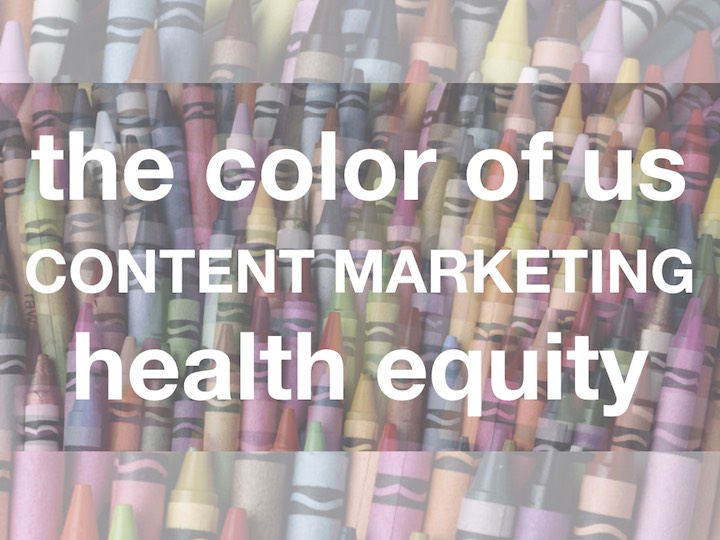We have been there before, in a meeting preparing to create a great healthcare communication campaign. We write the strategy and determine the tactics including many visual elements: video, imagery, social media posts, digital billboards. etc. It is time to schedule the video and photo shoots requiring the need to hire and recruit individuals to be featured in the photo and video deliverables.
You can feel it coming, and you have this undercurrent of worry. The photo and video sessions go really well, capturing lots of great content for the campaign. Then the bomb drops, you are reviewing all the great content and a voice in the room silences everyone, “you did not capture enough people of color.”
Everything…I mean everything comes to a complete…grinding halt. As you look around the room you notice a few things:
- Everyone is a loss of words.
- Pressure of the deadline looming invades the facial expressions of the team.
- You notice majority of the team members working on the campaign are not people of color.
I have experienced “this room” before! One memory always stays with me. It happened a few years ago while someone from leadership reviewing content created for the campaign, they asked, “where is the token black person.” As a vendor…I honestly froze and did not know how to respond.
Health equity starts at the top and is a cultural approach within every facet how the organization operates; all the way down to how you represent the organization through communications and outreach.
But I have a huge question, one that I grapple with across every piece of communication I create, what is the appropriate mix of people inside each piece communication? What ratios should be honored in each photo, each video, each voice for each piece of communication? How does each piece of communication best represent the organization and all the stakeholders: patients, employees, volunteers, community partners, vendors and the list goes on and on.
Here is another question, when someone looks at communication from outside an organization; what visual cues will determine whether the videos, photos, billboard, social media post or digital ad visually represent the demographic make-up inside and outside the walls? What indicator forces consumers to raise “red flags”?

I think about a book that is a part of Rosebud’s nighttime reading routine, “The Color of Us” by Karen Katz. It talks about all the different shades of skin color. As we read each page, a different shade of skin color is associated to a noun children understand. Different shades of skin are discussed including caramel, peachy tan, and cocoa brown; as we flip each page Rosebud names someone in her class that has each color. She looks at peachy tan and says my skin looks peachy tan.
As I read this book with her, I think…should I bring this book with me each time I start a video or photo project; requiring the team to define the different skin colors we will include? Or, should we be talking about our diverse population beyond the walls of color; specifically to include people with disabilities, different genders including transgender, ages, and color of hair?
My point here, when we are thinking and planning to intentionally communicate and engage our communities; how are we truly engaging in health equity? Is it an afterthought? Do we wait until the last minute to realize that we did not include a diverse population in our communications; a mixture of people that accurately represents the stakeholders and communities of the organization? Have we had serious conversations surrounding the ratios and percentage breakdowns of the organizations’s populations and when to appropriately represent each population within each piece of outreach?
Before we can have those conversations within the initial strategy sessions, we have to look within. What do the internal teams look like; yes, the teams that are working on these communication initiatives? It starts within! We cannot create communication without representation from diverse communities on the team. We have to be more inclusive on the inside to best communicate on the outside.
Looking in the Mirror
A few years ago, I was part of a communications board creating a large, regional communications conference. We spent over a year planning this conference with a great team of hard working, dedicated professionals volunteering their time. The call for speakers was complete and the team was sitting down to finalize the website including headshots from each speaker.
During the soft launch to local membership, we received a extremely upset email. The communication professional was interested in the event, but wanted to know why no one matched her skin color in the speaker line-up. The board panicked, and knew we had to do something. It was four weeks from the conference; we wondered…how do we create a more diverse speaker list when your budget is spent and speaker contracts and educational tracks are complete.
We had to stop and look within, there was not a single person of color on the planning committee; a committee created from a board of professionals with only two people of color represented. The board had to look within and embrace the lack of inclusion; then begin to systematically re-define what it means to intentionally engage the broader membership. The person that wrote the letter was asked to join the board and help us with this very hard question.
I think it is important to understand the meaning of health equity. The CDC Defines the following:
Health equity: Health equity is attainment of the highest level of health for all people. Achieving health equity requires valuing everyone equally with focused and ongoing societal efforts to address avoidable inequalities, historical and contemporary injustices, and the elimination of health and health care disparities.
As healthcare communicators, we must create communication that embraces inclusion at the most fundamental level engaging each member of our communities “in which people are born, live, learn, work, play, worship, and age that affect a wide range of health, functioning, and quality-of-life outcomes and risks.”
We must embrace all social determinants of health.
FYI…CDC defines:
Social determinants of health: Social determinants of health are conditions in the environments in which people are born, live, learn, work, play, worship, and age that affect a wide range of health, functioning, and quality-of-life outcomes and risks.
—–
Links:
https://www.cdc.gov/nccdphp/dch/pdf/HealthEquityGuide.pdf
https://www.cdc.gov/socialdeterminants/tools/index.htm

